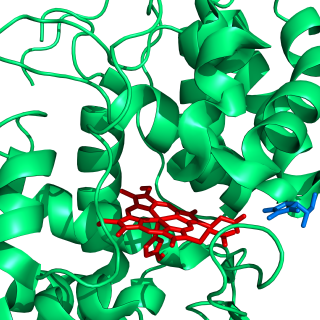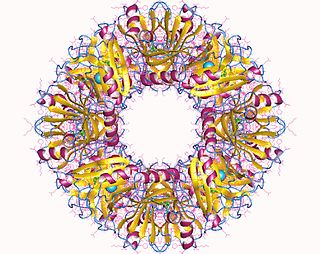
Lignin is a class of complex organic polymers that form key structural materials in the support tissues of most plants. Lignins are particularly important in the formation of cell walls, especially in wood and bark, because they lend rigidity and do not rot easily. Chemically, lignins are polymers made by cross-linking phenolic precursors.

The Polyporales are an order of about 1800 species of fungi in the division Basidiomycota. The order includes some polypores as well as many corticioid fungi and a few agarics. Many species within the order are saprotrophic, most of them wood-rotters. Some genera, such as Ganoderma and Fomes, contain species that attack living tissues and then continue to degrade the wood of their dead hosts. Those of economic importance include several important pathogens of trees and a few species that cause damage by rotting structural timber. Some of the Polyporales are commercially cultivated and marketed for use as food items or in traditional Chinese medicine.

Catechol 1,2- dioxygenase is an enzyme that catalyzes the oxidative ring cleavage of catechol to form cis,cis-muconic acid:

Ascorbate peroxidase (or L-ascorbate peroxidase, APX) (EC 1.11.1.11) is an enzyme that catalyzes the chemical reaction
Lignin-modifying enzymes (LMEs) are various types of enzymes produced by fungi and bacteria that catalyze the breakdown of lignin, a biopolymer commonly found in the cell walls of plants. The terms ligninases and lignases are older names for the same class, but the name "lignin-modifying enzymes" is now preferred, given that these enzymes are not hydrolytic but rather oxidative by their enzymatic mechanisms. LMEs include peroxidases, such as lignin peroxidase, manganese peroxidase, versatile peroxidase, and many phenoloxidases of the laccase type.

A wood-decay or xylophagous fungus is any species of fungus that digests moist wood, causing it to rot. Some species of wood-decay fungi attack dead wood, such as brown rot, and some, such as Armillaria, are parasitic and colonize living trees. Excessive moisture above the fibre saturation point in wood is required for fungal colonization and proliferation. In nature, this process causes the breakdown of complex molecules and leads to the return of nutrients to the soil. Wood-decay fungi consume wood in various ways; for example, some attack the carbohydrates in wood, and some others decay lignin. The rate of decay of wooden materials in various climates can be estimated by empirical models.
In enzymology, a lactaldehyde reductase (EC 1.1.1.77) is an enzyme that catalyzes the chemical reaction
In enzymology, a 1,3-propanediol dehydrogenase (EC 1.1.1.202) is an enzyme that catalyzes the chemical reaction
In enzymology, a cis-2,3-dihydrobiphenyl-2,3-diol dehydrogenase (EC 1.3.1.56) is an enzyme that catalyzes the chemical reaction
In enzymology, a naphthalene 1,2-dioxygenase (EC 1.14.12.12) is an enzyme that catalyzes the chemical reaction
In enzymology, a cellobiose dehydrogenase (acceptor) (EC 1.1.99.18) is an enzyme that catalyzes the chemical reaction

In enzymology, an oxalate oxidase (EC 1.2.3.4) is an oxalate degrading enzyme that catalyzes the chemical reaction:
In enzymology, a cysteamine dioxygenase (EC 1.13.11.19) is an enzyme that catalyzes the chemical reaction
In enzymology, a manganese peroxidase (EC 1.11.1.13) is an enzyme that catalyzes the chemical reaction

In enzymology, a NADH peroxidase (EC 1.11.1.1) is an enzyme that catalyzes the chemical reaction

In enzymology, a leucine dehydrogenase (EC 1.4.1.9) is an enzyme that catalyzes the chemical reaction
Haem peroxidases (or heme peroxidases) are haem-containing enzymes that use hydrogen peroxide as the electron acceptor to catalyse a number of oxidative reactions. Most haem peroxidases follow the reaction scheme:
Versatile peroxidase (EC 1.11.1.16, VP, hybrid peroxidase, polyvalent peroxidase) is an enzyme with systematic name reactive-black-5:hydrogen-peroxide oxidoreductase. This enzyme catalyses the following chemical reaction

1,2-dihydroxynaphthalene dioxygenase (EC 1.13.11.56, 1,2-DHN dioxygenase, DHNDO, 1,2-dihydroxynaphthalene oxygenase, 1,2-dihydroxynaphthalene:oxygen oxidoreductase) is an enzyme with systematic name naphthalene-1,2-diol:oxygen oxidoreductase. This enzyme catalyses the following chemical reaction

Extracellular enzymes or exoenzymes are synthesized inside the cell and then secreted outside the cell, where their function is to break down complex macromolecules into smaller units to be taken up by the cell for growth and assimilation. These enzymes degrade complex organic matter such as cellulose and hemicellulose into simple sugars that enzyme-producing organisms use as a source of carbon, energy, and nutrients. Grouped as hydrolases, lyases, oxidoreductases and transferases, these extracellular enzymes control soil enzyme activity through efficient degradation of biopolymers.










